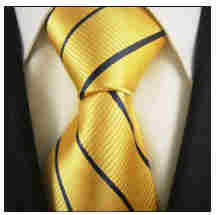|
in the court 
The [power] tie should be yellow with dark stripes (any color), or not so dark red with yellow stripes, which should be bar dextor [\] (neither neutral [X] nor bar sinister [/]). The front of the tie should end almost at the top of the belt. The other end of the tie should end no more than one inch above the end of the front. It may or may not have a tie tack to hold it in place. If you’re desperate, you could use a gold-colored paperclip. Most ties have a loop to hold the back in place. In heraldry, the tie is symbolic of when the knights carried their lady’s scarf, or it signified their status in the nobility structure. The bar dextor is used by the nobility. The bar sinister is used by illegitimate offspring of the nobility, and other subjects of the queen. We are not cowboys, Indians, or beachcombers, so the suit should be dark and plain with no pattern; black or dark blue is best. Decision makers such as judges generally prefer blue. Most tailors know how to adjust a suit so that the ends of the arms and legs are proper length. The shirt should be white, or very light coloring, plain with no pattern. The belt and the shoes should match and be black if they don't match the suit, or dark brown to match the suit.  The hat is optional according to one's preference. However, it should not be a cowboy hat unless you're in cowboy territory or a longshoreman's cap. Hats are more prevalent on the East Coast. Out West most people don't wear a hat (except possibly in San Francisco). To the uninitiated these ancient customs may seem frivolous. However there are natural subliminal psychological effects that must not be ignored when you are mixing with the power structure. Hat etiquette is important. It is based on the European customs that emanated from the days of chivalry and armor. Momentarily tip your hat or touch the brim with your right hand, or salute [symbolic of raising the visor of your armor to expose your face], when you meet or pass a friend or lady. Take your hat off whenever you're in a room or court. Your hat may be on when in the elevator, hallway, or outside, or in a room if you’re in strict business/battle mode. In court the judge may or may not be aware of heraldry. If you show up in court "out of uniform" or a bar sinister tie, and if the judge happens to be aware, then you have just visually broadcast to him that you are ignorant of such customs. That won’t make or break your case, but it does have a subtle effect on the judge. On the other hand, if the judge is not aware, then which way the bar goes doesn’t matter. In fact, his tie will probably be bar sinister since, as you must know, he is a subject of the sovereign people. In 1776 when the American subjects became sovereigns, American heraldry reflected the change. Until about 1970 European subjects wore ties showing the bar sinister and American sovereigns wore ties showing the bar dexter. During the following 10 years the bar dexter was phased out and ties became neutral in design for the 1980 decade. Starting in 1990 the bar sinister was phased in. By 2000 the transition was complete and now you must hunt in the clothing stores for the occasional bar dexter tie, especially a yellow one. Read the book, "Dress for Success" by John T. Molloy. There’s a good chance you will find it in the public library. It also has a special chapter written for women. The author was an engineer who got involved with the clothing business. He did actual practical testing on what clothes are the most effective in the business world. You will be amazed at some of the tricks he did to test effectiveness. While you're at it, also read his other book, "Live for Success". You will get a practical education about what is effective and not effective when it comes to personal image in the executive world, which includes the courts. The above suggestions are just that. If you deviate from those suggestions, then make certain that it is for a planned effect on the your subject, the judge. |